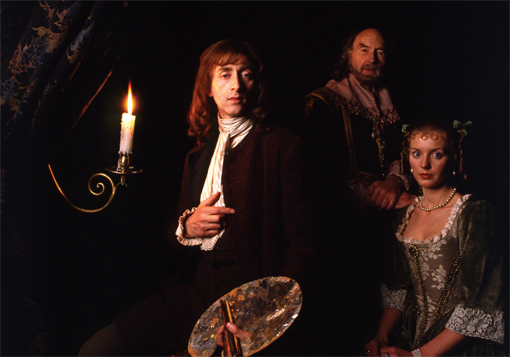Schalcken the Painter
2013. GB. Blu-Ray + DVD. BFI Home Video. 70 minues + 90 minutes extras. Certificate 15. RRP £19.00
 About the reviewer: Dr Stacey Abbott is Reader in Film and Television Studies at Roehampton University. Her recent publications include: Celluloid Vampires (University of Texas Press, 2007); Angel – TV Milestone (Wayne State University Press, 2009); Editor, The Cult TV Book (I.B. Tauris, 2010); c-editor with David Lavery, Supernatural: TV Goes to Hell (ECW Press, 2011); co-author with Lorna Jowett, TV Horror: Investigating the Dark Side of the Small Screen (I.B. Tauris, 2013). She is the Series Editor for I.B. Tauris’ Investigating Cult TV series of publications.
About the reviewer: Dr Stacey Abbott is Reader in Film and Television Studies at Roehampton University. Her recent publications include: Celluloid Vampires (University of Texas Press, 2007); Angel – TV Milestone (Wayne State University Press, 2009); Editor, The Cult TV Book (I.B. Tauris, 2010); c-editor with David Lavery, Supernatural: TV Goes to Hell (ECW Press, 2011); co-author with Lorna Jowett, TV Horror: Investigating the Dark Side of the Small Screen (I.B. Tauris, 2013). She is the Series Editor for I.B. Tauris’ Investigating Cult TV series of publications.
2013 was the year that the British Film Institute fully embraced the Gothic, hosting an outstanding four month season of Gothic films and television at the BFI Southbank (October 2013 – January 2014); releasing new prints of such classic cinematic examples of the genre as the digitally restored The Wicker Man: The Final Cut (Robin Hardy, 1973/2013), Herzog’s Nosferatu (1979) and Jack Clayton’s The Innocents (1961); and publishing a book of essays and critical reflections on the genre across cinematic, and televisual, history – Gothic: The Dark Heart of Cinema – A Compendium, edited by James Bell.
A further strand to this dazzling project is a series of Blu-ray/DVD releases including the BBC adaptation of Sheridan LeFanu’s ‘Strange Event in the Life of Schalcken the Painter’, published in 1839, and produced for television as part of the Omnibus series. Originally broadcast on 23 December 1979 in the tradition of the BBC’s Ghost Story for Christmas, Schalken the Painter stands apart from all other examples of Christmas ghost stories. In the tradition of the Gothic, it is by its own right a curious hybrid that unsettles its audience by its clash of creative intentions – a true artistic chimera.

LeFanu’s story weaves a Gothic narrative around – or perhaps extracting the story from within – the paintings of real life Dutch artist Godfried Schalcken (1643-1706). In adapting the story to the screen, Leslie Megahey is as interested in bringing the art to life as in telling this haunting ‘demon lover’ ghost story. The aesthetic approach to this strange and unusual ‘docu-drama’ is decidedly painterly, with virtually every frame composed to reflect the aesthetic design of Dutch painting and deliberately calling attention to the painterly qualities of the image. Compositions are still, characters artfully posed and the soundtrack is minimal, with little dialogue except for the lecture-style voice over, expertly delivered by Charles Gray. In fact Gray’s voice is one of the most unnerving elements of the programme, commenting upon the selling of a young women to a death-like suitor, and the subsequent horror that ensues, with the same tones as describing Schalcken’s paintings, his ambitious desire for critical respect or his penchant for brothels.
Visually, the ghostly elements to the narrative are equally painterly as the story’s monstrous spectre repeatedly appears silently out of the blackness of the shadows, evoking a sense that within Schalken’s paintings there is another unsettling narrative, hidden beyond the candle light within the dark. Special mention should go to lighting lameraman John Hooper for producing the most sumptuous shadows of any televised ghost story I’ve seen, drawing out of the story its Gothic origins while also paying homage to the distinctive colour palette and lighting texture of the Dutch painters. This is an arts documentary using the Gothic to provide an innovative and engaging entrance into the world of 17th Century painting and while not as frightening to me as other classic BBC ghost stories, Whistle and I’ll Come to You (1968), Ghost Watch (1992), and The Stone Tape (1972), it shares with each of them, their innovative and genre redefining approach to the Gothic.
To accompany Shalcken the Painter on this release, the BFI have included two short films – The Pit (Edward Abraham 1962) and The Pledge (Digby Rumsey 1982), each based upon diverse gothic/fantasy stories: Edgar Allan Poe’s ‘The Pit and the Pendulum’ and Lord Dunsany’s ‘The Highwayman’. These two films are masterful and experimental adaptations that draw out from their unsettling aesthetics a disturbing atmosphere of madness and despair. They remind us that experimental cinema is often able to capture the emotional experience of the gothic through its often discordant juxtaposition of sound and image. Well worth watching and a delight to now have available for home viewing, this Bluray/DVD package should open up thinking on the Gothic in new and exciting ways.
Dr Stacey Abbott
 Learning on Screen
Learning on Screen